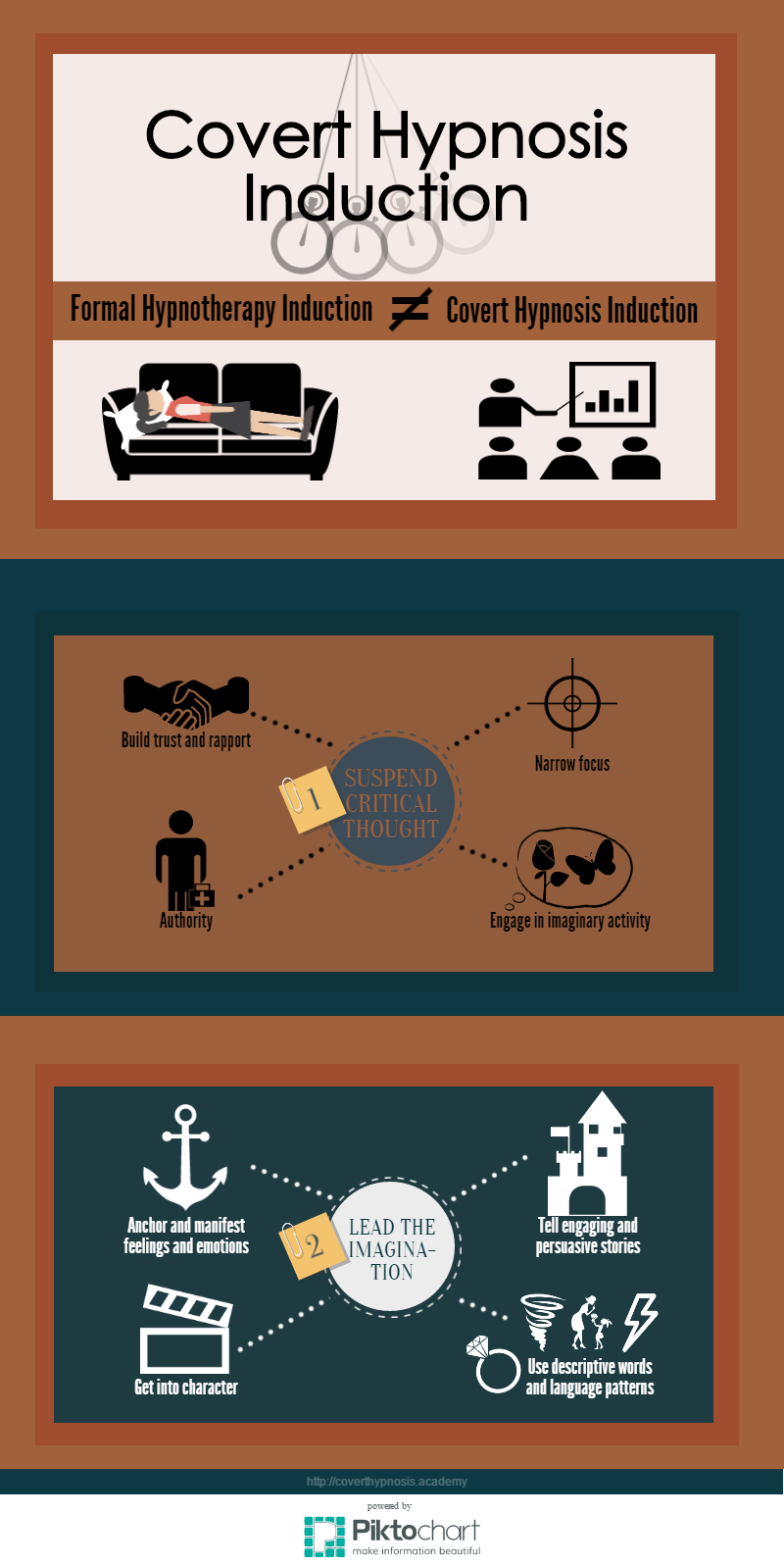Hypnosis induction is, of course, one of the core parts of hypnotic influence.
However, in a covert setting, hypnosis induction will vary considerably from a formal hypnotherapy setting.
Here we’ll take a peek at some of the secrets of inducing hypnosis in a subliminal way, that is, in a way that isn’t perceivable by the subject (in this case a listener or a reader) consciously …

For Hypnosis Induction To Happen, We Have To Basically Achieve Two Things
We have to bypass the critical factor of the conscious mind and we have to capture and lead the imagination of our listeners. Basically we’re taking them from “here and now”, from their current thought patterns into our desired directed thinking.

When you’re persuading someone with covet hypnosis, your job is to take them from “here and now” to the desired place and state in their mind where they automatically do whatever you want them to do
Bypassing The Critical Factor Can Be Achieved In Many Different Ways
For example, when we build trust for us in a person, he or she will much less critically evaluate what we say than if we don’t do it. Being a perceived source of valid information is a very strong demolisher of critical thought. Just look at the media and the ease with which they shape public opinion! For most people, turning on the news is an instant hypnosis induction.
Another way of bypassing the critical factor is getting people really absorbed and focused on something. In a formal hypnotherapy setting, this is achieved by really focusing a person on relaxation. In the army they do it by giving soldiers constant chores and duties which they must complete with top performance. In a business setting they do it by keeping people as busy with work as possible. Curiosity might also fall under this category.
Yet another way of bypassing the critical factor and because of its speed and effectiveness very useful in covert hypnosis is by simply indirectly telling the conscious mind that there’s no need for its critical factor, as what follows won’t directly impact the person.
Think about it… when you go see a good movie, do you empathize with the characters or do you say for example: “well, he’s an actor anyway and he’s not really a bum and he went back to his Villa after shooting this movie. No, I won’t feel sorry for this character”? No. Because your critical mind is at rest and there’s no objection, your subconscious mind reacts to the environment – and you literally feel bad for the character.
A great use of this is to engage a person in some imaginary activity. For example, telling a story or using phrases such as “have you ever” or “what’s it like when” or “imagine” to create powerful language patterns that temporarily suspend the critical factor and let you easily capture and lead the imagination of a person you’re talking to.
Another good way to get away with a lot of descriptive language and subliminally setting the mood to get the desired result is using quotes. Quotes put the listener or a reader at ease because now you’re not trying to persuade them, you’re just saying what someone else said. Their guard (critical faculty) goes way down and you have an opportunity to evoke feelings and emotions at will.
What’s best, in case something goes wrong and they totally disagree, you can always say it was them and not you…
—— Example of using quotes —–
—— End of example of using quotes ——
I wanted to give you just a short example and it turned into a slightly more elaborate one (I got carried away like I do a lot).
Anyway, the last thing I want to talk about is a way of bypassing the conscious mind altogether. This means that you’re communicating with a person in a sort of a subliminal hypnosis way. Now, all the methods here describe how to subliminally induce a suspension of critical thought. This last way is not about suspending it, but literally bypassing it altogether…
An example of such way of communication are embedded commands. We’ll discuss embedded commands more thoroughly in a future article, but in essence embedded commands are short statements or words within a sentence that are somehow marked out for the subconscious to notice (for example said in a very slightly different way). Conscious mind, being linear won’t pick up on them, but subconscious will and will start acting on them immediately.
So, after bypassing the critical factor, there’s another thing we must do…
Capture And Lead The Imagination Of Our Listener
The important thing here is to grab attention and hold it.
Notice how stories utilize many of the critical factor suspending techniques as well as capturing and leading the imagination of the listener. A good story is a powerful hypnotic tool and learning how to tell stories is one of the most important covert hypnosis skills.
Hypnotic language patterns work well, if used correctly. These are short, usually memorized scripts, if you will, that contain the elements of a persuasive process, where you simply fill in the blanks to tailor them to your situation. I showed you one such pattern in the example of using quotes and we’ll extensively talk about them in another article.
The aim is to get a person to think in a certain direction we desire without reactivating the critical factor. Although it will be temporarily suspended, strong stimuli (a huge lie, things that totally violate the values of the listener…) will get it up and running in no time. Be careful there.
OK, now hopefully you have a better idea of what hypnosis induction in covert setting is like. Note that our listener usually won’t close his eyes, give us permission or become completely unconscious. It doesn’t work that way. He will, on the other hand, become much more reactive and sensitive to our suggestions and this is what essentially hypnosis induction is all about…
Join The Covert Hypnosis Newsletter And Instantly Get 6 powerful Audio Lessons On MP3 Free!
Want to take your covert hypnosis to the next level?
Accelerate your persuasion study with up-to-date information for mouth-watering application. The moment you sign up for free, you’ll get access to six 20 minute long audio lessons explaining in detail the six steps of “the covert hypnosis formula” to give you solid foundation for becoming a persuasive powerhouse.
You can join the newsletter here.